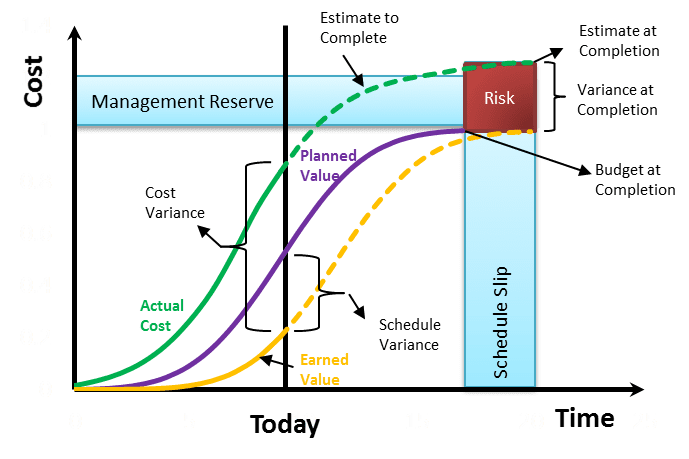Earned Value Management System = Get Paid!
Bottom line: you don’t get paid, if you don’t show earned value. Usually earned value is done during key milestone such as: preliminary design review (PDR), critical design review (CDR), test readiness review (TRR), first article inspection. In the real world, you will see management pushing on holding key milestone reviews, since it is associated with invoicing for payment. It is critical for engineers, managers, and supporting functions to understand payment milestone drive the schedule.
 An EVMS Earned Value Management Systems is a method used to track project performance and forecast future performance. An EVMS integrates performance, cost, schedule and risk management of a project and provides early warning of risks and problems. Provides accurate response to management; are we behind or ahead of schedule, are we under or over budget, what will be spent on the whole project. It provides an EVMS and reporting system to use as a tool to manage the timely indication of work progress, early identification to problem areas, potential issues, and performance trends which give the project manager the ability to project controlling the baseline.
An EVMS Earned Value Management Systems is a method used to track project performance and forecast future performance. An EVMS integrates performance, cost, schedule and risk management of a project and provides early warning of risks and problems. Provides accurate response to management; are we behind or ahead of schedule, are we under or over budget, what will be spent on the whole project. It provides an EVMS and reporting system to use as a tool to manage the timely indication of work progress, early identification to problem areas, potential issues, and performance trends which give the project manager the ability to project controlling the baseline.
Table 1 Earned Value Parameters and Performance Variance

The benefits of understanding the EVMS process is that the program effectively integrates performance, time, cost, & risks. All the EVMS variables are defined in Figure 1 Earned Value Management Systems and Table 1 Earned Value Parameters and Performance Variance shows how the EVMS is measured.
History of EVMS:
Cost and Schedule Control Systems Criteria (C/SCSC) used in DoD for more than 35 years, DoD 5000 series contains 35 criteria. In 1996, C/SCSC transitioned to EVMS containing 32 guidelines. In 2003, DoD raised concerns and actioned government/industry to establish EVM working groups. In 2005, Office of Management and Budget (OMB) implemented EVMS on all federal agency capital asset acquisitions and inter-agency work.
EVMS is a requirement of many U.S. Government agencies such as: Department of Defense (DoD), Department of Transportation (DoT), Department of Energy (DoE), Department of Homeland Security (DHS), National Aeronautics and Space Administration (NASA), Federal Aviation Administration (FAA), and others. This is why you have to conform, you want their money and you want to get paid.
The ANSI/EIA-748-C EVMS Standard contains a set of 32 Guidelines that defines the requirements EVMS must meet. There are 5 phases of EVMS process:

-npp
